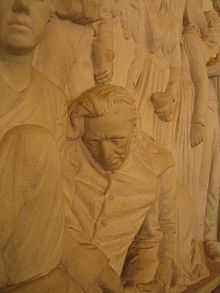Romano Romanelli
Romano Romanelli (7 January 1882 – 20 January 1969) was an Italian sculptor.
Prof. Romanelli was born in Florence, the son of sculptor Raffaello Romanelli, who created works such as the "Monument to Garibaldi" (1895) for Siena, in a vigorously impressionistic 'verist' style. His grandfather Pasquale Romanelli was also a sculptor, and collaborator with Lorenzo Bartolini.
Personal life
In 1925 Romanelli married Dorothea Hayter, daughter of Rev. William Thomas Baring Hayter.[1] He had created a sculpture of his future wife in 1917,[2] when he had been a naval officer in Gibraltar. They had three children - a son, Raffaello Romanelli (b. 1926), named after Romano's father, and two daughters, Costanza (born 1928 and later married to Bettino, barone Ricasoli Firidolfi) and Ilaria (born 1934 and later married to Arnaud Faure).
Naval Service
Romano Romanelli attended the Italian Naval Academy and in seven years of service eventually rose to the rank of commander. As a cadet and junior officer in the Italian Navy, he made five voyages, visiting the Mediterranean, North America, and Europe including the Azores and Madeira. He served for three years in the Far East, including China, Japan and Siberia, the Dutch and British East Indies, the Indian Ocean, and the Red Sea. In 1909, while in the Navy, he left contracted a serious case of dysentery and left the service in 1910 for medical reasons and began to work as a sculptor. Recalled into the Navy for the Italo-Turkish War in 1911-12, he served as a navigator in an armed cruiser patrolling in the area between Corsica and Palermo, Sicily. Recalled again in 1914 at the outbreak of World War I, he was appointed officer in command of the Southern Adriatic and Ionian Sea. He subsequently commanded an auxiliary cruiser, and in 1918-19, he was based at Gibraltar, where he was the Italian naval officer assigned to in cooperation with other allied navies concerned with protecting merchant vessels from U-boat attacks in their passage between the Straits of Gibraltar and the Italian coast.[3]
Career as a Sculptor
Romanelli created both large scale works and smaller statues, usually bronze, of around 60 centimeters. He was named an Accademico d’Italia in 1930. His works include a bronze crucifix for the 1934 Crypt for the Fallen at Santa Caterina a Magnanapoli, Rome.

After World War II, Romanelli's workshop was involved in the creation of the historical friezes for the Voortrekker Monument in South Africa. The design was created by four South African sculptors Hennie Potgieter, Laurika Postma, Frikkie Kruger and Peter Kirchhoff who spent five years creating plaster of paris panels. These were sent to Florence where Romanelli had a large studio with machinery and technical equipment. He directed 50 chisellers replicating the plaster of paris designs in Quercetta marble.[4]
Selected works
- Il Portatore d'acqua 1912
- Miss Dorothy Hayter 1917
- Eva, 1919
- Lo Scultore
- Giano e la vergine, 1930
- Hercules with the lion
- The Boxer
References
- ↑ GeneAll Net
- ↑ Masters of Twentieth Century Figure Sculpture - Tuscan
- ↑ "Scrittori Marinari: Romano Romanelli," Corriere Padano, 7 January 1942
- ↑ The South African Military History Society
External links
|